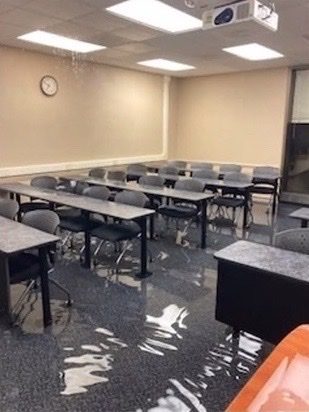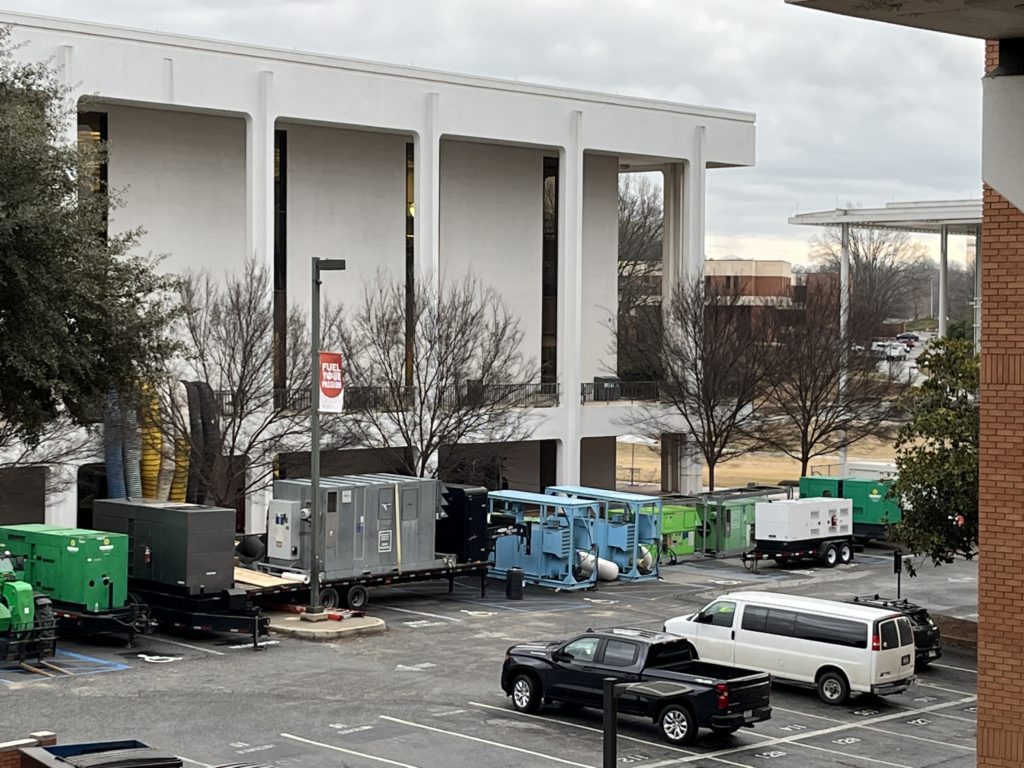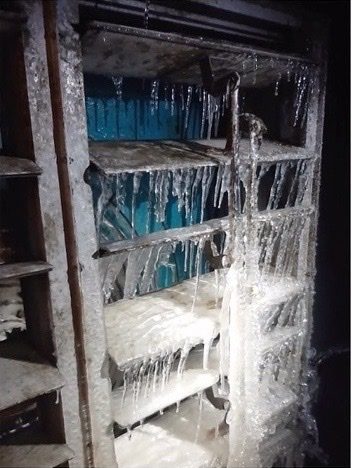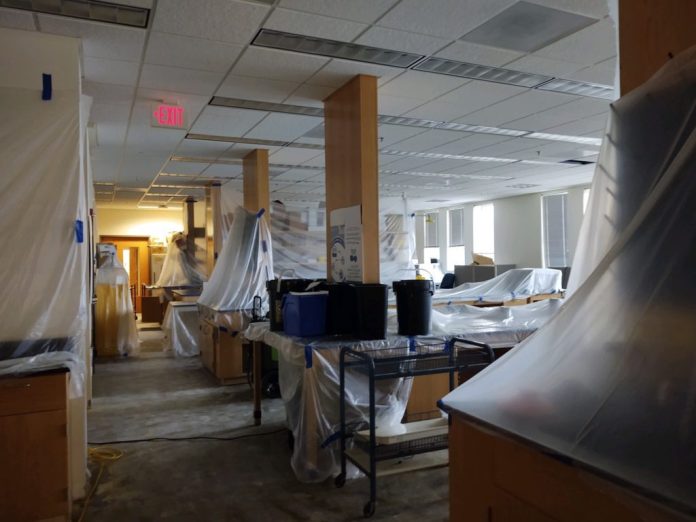January 25, 2023 January 25, 2023
Brianna Lombardozzi had started preparing Christmas Eve dinner for her family when she received a call about a burst sprinkler head at the Lightsey Bridge apartments. Anthony Harvey’s phone rang just as he and his wife began exchanging Christmas presents. The notification from Dr. Leasa Evinger arrived while wrapping presents before a Christmas Eve service. Over the next few days and weeks of the winter break, scores of university staff put their plans on hold and returned to the main campus to repair the 35 buildings that had suffered millions of dollars in damage due to the extreme cold at the start of the spring semester, just a few weeks away.
The combination of single-digit temperatures and a loss of steam for heating caused building temperatures in the main campus to drop rapidly, resulting in flood damage from primarily frozen coils in air units and sprinkler systems. The incidents happened over several days and required immediate response and coordinated recovery efforts.
Alerts and calls to the Clemson University Fire Department began at 8:30 a.m. on December 24 and did not stop until 10 p.m. that night, according to Jessica Landreth, Captain of the Clemson University Fire Department.
“As a shift supervisor, I oversaw the deployment of the units for multiple calls at the same time as responding to and handling calls myself,” Landreth said. “The number of calls we have been faced with is not routine and is very tiring for our units.”
 Water drips from the ceiling of a flooded Cooper Library classroom.
Water drips from the ceiling of a flooded Cooper Library classroom.
CUFD and the Clemson University Police Department worked with university facilities and the housing and dining area to respond to alarms across campus. Christmas Day brought new problems, including massive water damage at the RM Cooper Library. The university immediately commissioned the rehabilitation service provider SERVPRO with the water extraction, drying and demolition.
The changing nature of the incidents presented particular challenges. Employees going to one building to investigate heard or saw running water in another. Buildings that showed no problems during morning surveys sounded alarms in the afternoon as warmer temperatures thawed frozen pipes. More areas became visible Monday that require attention before temperatures finally remain above freezing.
62 staff from university facilities played key roles in the university’s response, along with staff from housing, occupational and environmental safety, CCIT, emergency management and others.
“I’m honored by the commitment of the university facilities team and am truly grateful for the resilience they have shown during difficult times,” said Todd Barnette, chief facilities officer. “Thanks to their dedication and the dedication of our university partners, what was a potentially disruptive event turned into a successful campus reopening with limited impact on the students, faculty and staff we serve.”
Go beyond measure
 SERVPRO units lined up in front of the Cooper Library demonstrate the response needed to prepare the library for the start of spring classes.
SERVPRO units lined up in front of the Cooper Library demonstrate the response needed to prepare the library for the start of spring classes.
Brianna Lombardozzi and Christine Charette, Community Director, arrived at Lightsey Bridge on Christmas Eve to find student housing inch by inch waterlogged – a scene they would witness in several areas over the next few days when recalled from their homes. When facility staff stopped the water, shelter, facility, and custodial staff began documentation and cleanup efforts.
“Our first response was, ‘What can we put on the floor?’ What can we salvage at the moment?’” said Lombardozzi.
The day after Christmas, residential staff returned to collect, wash, dry and fold the belongings of the 12 affected students in the shared laundry room before delivering them to their relocated living quarters after the New Year. They received another call later in the night when another building – Calhoun Courts – began leaking water through the ceiling. Throughout the break, staff have been in contact with students to provide information on the condition of their homes, to offer to provide pictures or video calls to their rooms, and to accommodate any requests related to the careful relocation of their personal belongings.
“We have exercised the utmost discretion and diligence because we wanted everything to be sorted for her when she returned,” said Leasa Evinger, Head of Residential Living. “We really focused on that, mostly because the students weren’t here to mind their own stuff.”
I haven’t heard anyone complain. Nobody said “no”. That was one of the things I will always remember… it was a great team effort with everyone coming together to help.”
Anthony Harvey, Assistant Director of Facility Maintenance
Doing laundry was by no means the only extraordinary task. Flooring removals found that asbestos was decreasing in several nonresidential buildings, labs had to be checked for hazardous materials and equipment malfunctions, and classrooms had to be cleaned before classes began on January 11.
Jim Grieger, executive director of the Office of Occupational and Environmental Safety, coordinated the work with water-affected researchers and administrators.
“Everyone was determined to respond and fix the problems,” he said. “The responders I worked with all sacrificed vital personal time to ensure the university could be operational again. It was great to see and I am fortunate to work with such professionals.”
 Frozen chimneys in the Biosystems Research Complex.
Frozen chimneys in the Biosystems Research Complex.
Anthony Harvey, the assistant director of facility maintenance, was the one who called Brianna Lombardozzi on Christmas Eve. He will never forget the camaraderie of those who have given up time with their friends and family.
“I haven’t heard anyone complain. “No one said ‘no,'” he said. “That was one of the things I will always remember. It’s not an easy job when water is coming down and you’re trying to move heavy carpets, but it was a great team effort with everyone coming together to help.”
Work on several buildings, including the Cooper Library and Calhoun Courts, continues before they are fully operational.
The university is investigating what circumstances caused the damage and what lessons can be learned to prevent future incidents.
“Whenever you have something like that, you have to learn from it. “We’re looking at everything to see how we can be better prepared so something like this doesn’t happen again,” Barnette said. “But as for our response, I can’t question anything. It was second to none.”
news.clemson.edu
https://news.clemson.edu/clemson-employees-provide-critical-support-to-address-flooding/














